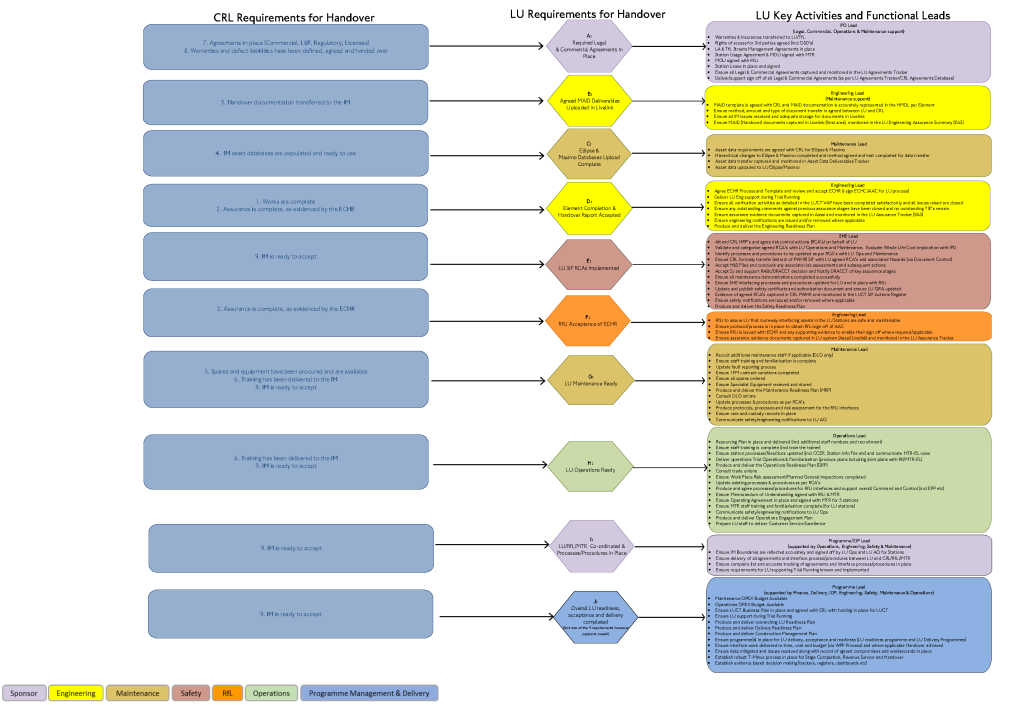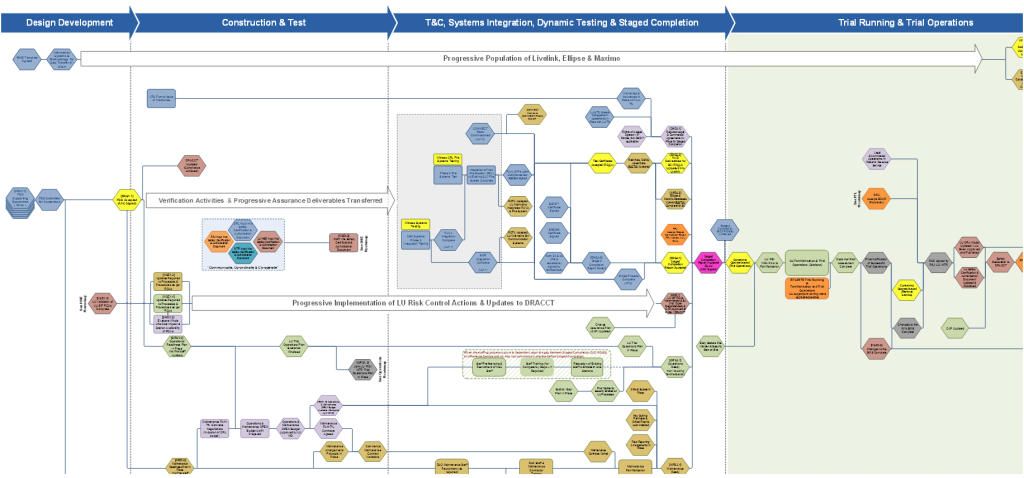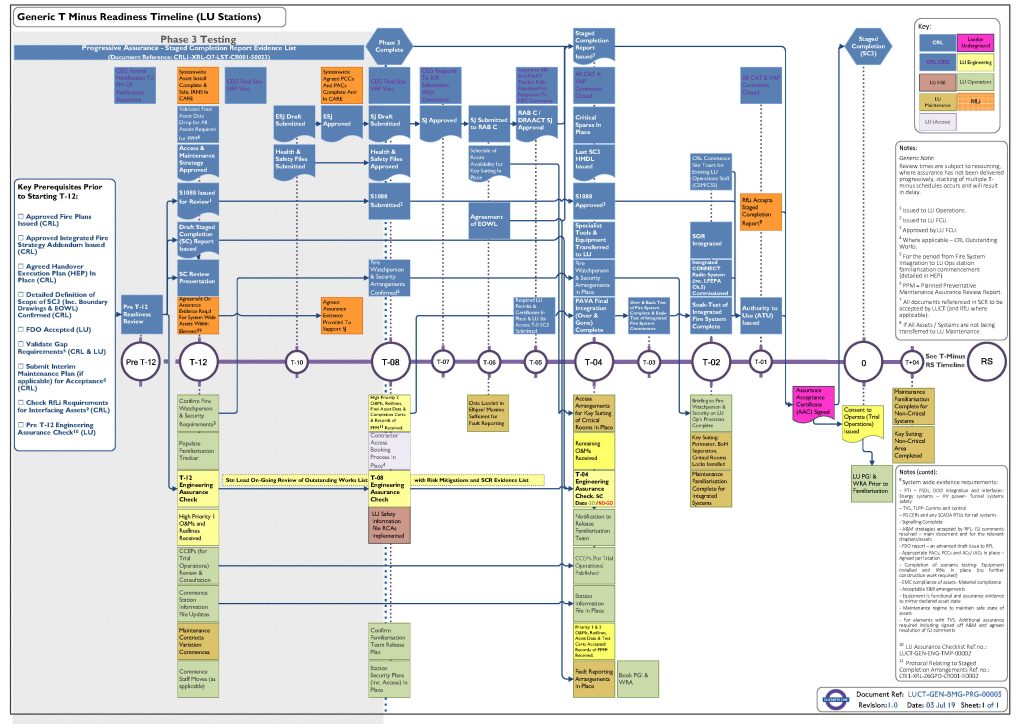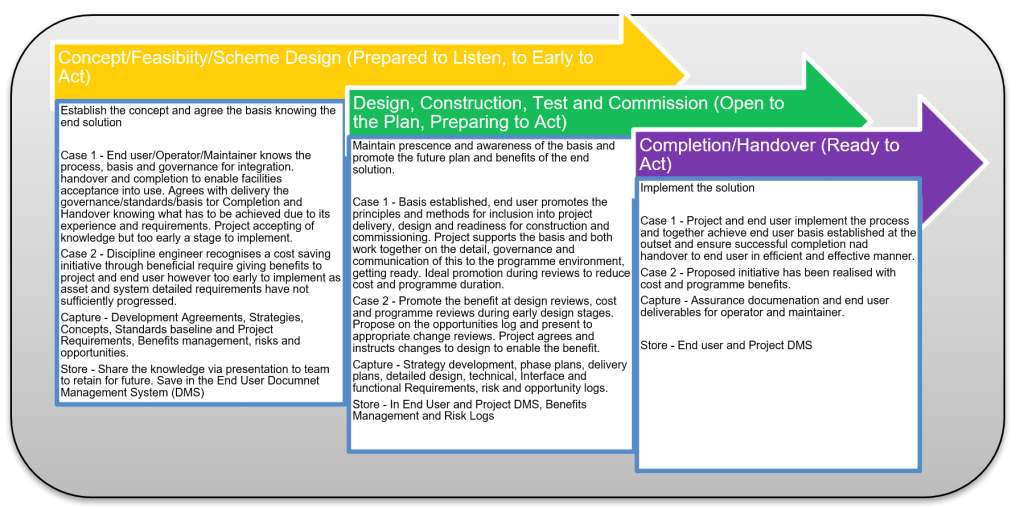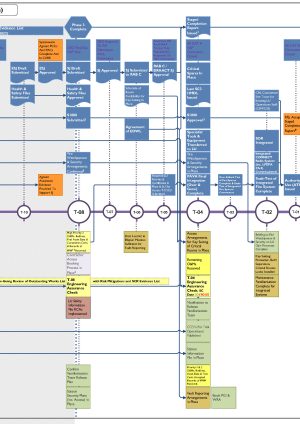
Stations Bringing into Use and Handover
Document
type: Technical Paper
Author:
Glen Ager CEng MCGI MIET, William Dennis
Publication
Date: 18/05/2023
-
Abstract
This paper highlights key lessons and recommendations that have emerged through the successful integration, bringing into use and handover of the new central Elizabeth line stations by Crossrail to the Infrastructure Maintainers as end-users.
The paper details the organisational arrangements and tools and techniques that achieved this and makes recommendations for future projects. It considers the importance of starting with the end in mind, supported by a clear mission statement and the definition and articulation of requirements that achieve that. It then details several tools and techniques utilised by the CRL and IM organisations to facilitate these activities, such as the Configuration Statement and the T-minus process. Finally, it outlines the importance of the smart end user and the development of trust and collaboration between the delivery and end user teams.
The lessons and recommendations detailed in this paper provide a toolkit that can benefit any organisation as part of small, major or complex programmes to maximise likelihood of success, but has particular applicability within TfL project delivery.
-
Read the full document
Introduction
During 2020-22 Crossrail Ltd delivered ten major new stations as part of the Crossrail programme; commissioning, bringing into public use, and ultimately handing over to the end user (the Infrastructure Manager, or IM), culminating in the opening of the Elizabeth line (EL) in May 2022. This represents an unprecedented level of commissioning, integration, and handover activities in a relatively short period of time – this level of activity had not been achieved within Transport for London (TfL) before.
Nine of the new stations were ultimately delivered to two IMs, Rail for London Infrastructure (RfLI) and London Underground (LU), with four and five stations handed over respectively. The five being handed over to LU because those new EL stations were adjacent to existing LU stations and would require significant integration between new and old. The paper focuses on the integration, bringing into use (BIU) and handover (HO) of the LU stations because this represents the management of change to an existing part of the network, rather than entirely new infrastructure, and therefore ultimately provides greater applicability to project delivery within TfL. Nevertheless, the lessons and recommendations are equally applicable to project delivery and handover within RfLi.
The delivery into public use, and ultimately handover, is a complex undertaking with many years of work required. The paper focuses on the latter stages of these activities but draws relevant lessons from earlier in the lifecycle. CRL and LU worked to integrate the new stations with existing LU infrastructure; for example safety critical systems (fire, communications etc) are controlled from one station operations room. Project delivery and such integration activities culminated in a station achieving BIU which for CRL meant that in accordance with the Railways and Other Guided Transport Systems (Safety) Regulations 2006 (ROGS) it was ready for operational staff and use by the public, subject to successful completion of trial operations, and ready to be maintained by the IM. In LU Assurance Standard (S1538) terms, BIU was referred to as Staged Completion and HO as Completion, whilst within CRL these were referred to as SC3ROGS and Handover respectively.
This paper does not go into technical detail on specifics of these activities, which are covered by other learning legacy items, but details the organisational arrangements and processes required to facilitate successful delivery of those activities and makes recommendations for future projects which are applicable throughout the industry but will be particularly useful within a TfL project delivery and handover context.
The Crossrail project represented a significant change (risk) to LU, due to major additions being introduced on and around the existing railway. To mitigate these risks, LU created the LU Crossrail Team (LUCT). LUCT was set up as the interface team between CRL and the LU business and was the acceptance authority for the five central section stations for which LU became the IM. Key objectives of the team included not only infrastructure protection responsibilities, but also to facilitate the build through LU delivery of interface works (such as systems integration), and position LU to accept, then operate these stations.
The requirements and the relationship between CRL and LU were formalised via the LU/CRL Development Agreement (DA). LUCT worked closely with CRL from the beginning, being heavily involved in operational concepts and functionality requirements for both the operator and the maintainer. LUCT also played a significant role in Integrated Design Reviews to ensure the final product was fit for purpose. However, the paper highlights how this relationship was not always as collaborative as it needed to be and how it was really only after the announcement of the delays in 2018 that the relationship really helped to “pull” the stations to BIU, and how successful project delivery and handover is underpinned by this collaboration.
The Mission Statement
Establishing and maintaining focus and awareness of an effective mission statement has proven very effective throughout the duration of the Crossrail programme and was a key contributor to the success of the stations delivery by CRL and the IMs. The mission statement helped unify the team and enable all members to tailor their activities and goals towards it. In the latter stages of the programme, it was vital in articulating the end user focused objectives that could only be achieved by the CRL and IM teams working together. It is a simple but effective tool, which in early stages of the project lends its prominence to setting the goals of emerging strategies and plans, and in the latter stages of the programme sustains the focus needed for the team and its members to stay on track and prioritise what’s important.
Figure 1 – Example of an end user-oriented mission statement
An effective mission statement will instil team work ethic, unify the mindset of the organisation and increase cooperation and camaraderie. It reinforces the teams’ behaviours and gives them backing to their decisions made in support of it, allowing them to stand robust on the mission statement and team objective. In this way it has an added benefit of giving any interfacing organisation confidence in any direction given, challenges made, cooperation and knowledge share, cementing interface relationships through confident and forthright working backed by its reason for achieving – the mission statement.
Defining the Requirements
(i) The Essential Requirements
Coupled with a clear mission statement, clarity on the fundamental requirements to achieve a given milestone is vital to achieving objectives. Establishing a suite of distilled and highly accurate and achievable requirements which are essential to the milestone is crucial and not necessarily part of the more detailed technical requirements that underpin the scope of a project. These essential, or minimum, requirements bring clarity at the times when focus, objectives and goals can become least clear.
During the period of 2016 to 2017 workshops were established engaging consultees across the IMs to ensure representation of all functions and disciplines. Each consultee was tasked with determining the essential requirement for their aspect, without which it would not be possible to determine the assets sufficiently safe, complete, assured, and acceptable for operation and maintenance. Fundamental to the consultees being able to define such essential requirements was not only the level of competence, knowledge, experience and understanding they held of their own discipline and functional areas married with the business needs and standards but also having a deep understanding of the delivery organisations design, specifications, project standards and level of progress achieved at any given time.
These essential requirements allowed the delivery organisation to focus and prioritise works on what ultimately supported achievement of delivery milestones. During 2017-2019 the Crossrail Programme team did not sufficiently engage with the end user requirements. However, over time, and with the new team and focus brought to bear in the programme recovery period post 2018, this changed. Presentation of this information was sustained at all levels and kept present in delivery teams’ mind as the key to unlocking successful completion and transfer of assets and systems.
During key stages of commissioning through to completion, trial operations and revenue service these essential requirements became fundamental building blocks of the suite of tools and techniques described in this paper.
Figure 2a – Extract of the purpose of the LU Asset and Systems Priorities matrix which established the first essential requirements (2018).
Figure 2b – Extract of the supporting essential requirements matrix
Figure 2c – Extracts from the LU Asset System Essential Requirements LUCT-GEN-BMG-LST-00008 in its final format as a clear distilled suite of essential requirements with minimal acceptable position and expected assurance documentation.
(ii) The Nine Requirements of Handover
Building on the essential requirements, the Nine Requirements of Handover (9ROH) represented a single set of high-level objectives and linked tasks for both CRL and LU which were required to be completed in order to determine that Handover could be achieved. This gave clarity of purpose and evidence of thinking with the end in mind from the outset and was integral to defining what was required to meet critical milestones.
A Handover will be achieved once the following nine requirements are satisfied:
1. Responsibilities and Accountabilities change
2. Handover documentation transferred
3. All necessary agreements in place
4. Works are complete
5. Training delivered
6. IM Readiness
7. Spares and Equipment
8. Warranties and Defect Liabilities
9. Asset Inventory Database
Figure 3a – Abridged listing of the 9ROH
The 9ROH were established through ~10 joint workshops in 2017-18 across the CRL and LUCT integrated organisation to form an agreed and documented position enabling straightforward decision making, tracking of progress and reporting against. They gave a commonality of purpose, and supported demonstration of the CRL four pillars of assurance (Safe, Operable, Maintainable, Performs) and could be linked to the essential requirements.
Establishing the 9ROH enabled a suite of primary tools including the routemaps (explained in Shaping the Outcome section below), T-minus (a countdown process of key deliverables set over specified period of time to control and manage the achievement a given output involving many stakeholders) and essential requirements to ensure from all aspects of the programme (planning, assurance, delivery, commercial, legal, operational, safety etc) it was clear on what needed to be achieved to facilitate a safe and legal Handover. This baseline enabled CRL and LUCT to make risk-based decisions to deviate from this, where the situation required, using tools such as the Configuration Statement
Figure 3b – Sample of the 9ROH for CRL and associated tasks
Configuration Statement
The essential requirements and the 9ROH, enabled CRL and LUCT to confidently change course when the situation needed. This was most critical during the implementation of the recovery strategy that was developed in response to the announcement of the delay to opening in 2018. This has been well described in other papers[1], but can be summarised as a phased approach to the BIU and Handover of the Stations, which facilitated both the stations and routeway operational staff undertaking familiarisation, trial running and trial operations. Originally, Crossrail had set to achieve a full and final completion before handing over to the end user. This change in approach was vital to opening the Elizabeth line in 2022.
In order to avoid any subjective debate over whether a station was ready for a given stage such as trial running, or BIU, it was necessary to establish a means for assessing the readiness against essential requirements.
This took shape as a Configuration Statement jointly produced between Crossrail and the IM. Whilst not explicitly part of the practice of industry recognised configuration management per se, it used the principles of clearly recording and recognising what was being provided and documented the state of completeness for any given asset, system, or facility. The basis of the Configuration Statement in this respect was to evaluate the approved final design against the as-built status and assess against the essential requirements at intervals throughout the countdown to a given stage.
Each Configuration Statement contained an overall assessment of the facility being Safe, Operable and Maintainable (or collectively ‘tolerable’) for the intended milestone. Generally, if required items were not completed for the milestone, with no feasible, safe or legal mitigation then the configuration would be ‘intolerable’ and delivery would continue until ‘tolerable’ was achieved.
This approach enabled CRL and LU to make tactical risk-based decisions on the completion of works at a particular station at intervals (weekly, sometimes daily) towards a milestone and to undertake prioritisation of delivery activities in support of that milestone. Despite the introduction of the phased approach to integration and commissioning of the stations, CRL’s aim was always to complete all requirements. However, practicalities such as access constraints, supply chain performance and sequencing issues meant that this was not always possible, and decisions needed to be made as to what was fundamentally required to safely operate and maintain a station.
The process was carried out by exception, assessing only works not sufficiently complete, and was conducted by utilising the Crossrail records of outstanding works and defects which represented what needed to be achieved to establish a fully complete and assured station. LUCT had the capability to assess these outstanding works against the essential requirements and therefore help CRL prioritise those which were necessary to achieve a given stage or milestone, those which would need mitigation if not achieved and those which could be delivered subsequent to the stage or milestone. Mitigation at the countdown stage to a milestone would typically only be operational or maintenance based, such as increased inspection routines, addition of added security personnel, fire watch persons or technical expertise to assist operational staff
Figure 4 – Sample of a configuration statement assessment table
For such an approach to be successful, collaboration between the CRL delivery teams and LUCT was vital, underpinned by a clear mission statement and essential requirements. Further, it was essential that LUCT, supported by CRL, collectively used its deep understanding of operating and maintaining the underground network, its standards and legal requirements, overlayed by an extensive understanding of the project, programme, plans, strategies and assurance procedures to support the phased delivery of the CRL programme.
‘Be an integrated part of the delivery to drive the desired outcome and support its development to maintain programme’
Mind the gap
CRL and LUCT could confidently vary integration and commissioning approaches in support of strategic changes using the combination of a clear set of essential requirements, underpinned by 9ROH, plus the tool to make risk-based decisions to implement changes to this (the Configuration Statement).
One such strategic change with wide ranging ramifications for the stations integration and commissioning activities was the decision, described earlier, to move away from the ‘big bang’ commissioning and opening approach and use a phased approach to the commissioning (BIU) and HO of the Stations. This approach was taken to reduce complexity, provide greater cost and schedule certainty, and to help de-risk the programme.
There were two aspects to achieving this, which CRL and LUCT worked closely to agree and then implement. The first aspect was to separate the requirements of safety and legally assured assets/systems (under ROGS, Health & Safety at Work Act, Development Agreements) from those which were necessary to facilitate the end user’s maintainer taking responsibility for full care and custody/maintenance of those assets and systems (9ROH, LU Standards etc.). Once it was clear what legally needed to take place it was possible to then apportion those assurance deliverables and requirements which CRL were required to provide between those associated with safe and legal BIU and those related to HO.
With this complete, LU and CRL needed to determine how the period between BIU (the point at which LU became legally responsible for management and maintenance) and full HO. Legally the end user was required to take responsibility for use and maintenance at the same time (BIU), however this could not happen as CRL had not completed all physical works and thus could not provide full and final assurance documentation. The second aspect, therefore, was the deployment of an interim maintenance arrangement (IMA). The IMA created a working arrangement between CRL and LU which detailed how assets or systems which were sufficiently complete and assured for BIU, but not for HO, could continue to be planned and reactively maintained by CRL or LUCT until further assurance had been produced. This arrangement allowed LU to legally take maintenance responsibility with a documented safe maintenance regime in place. This was deemed low risk to LU, as CRL had been maintaining the assets and systems for many months or years and had been meeting statutory maintenance requirements during that time.
From an organisational perspective, linking the transfer of responsibility for maintenance to a BIU milestone was a powerful way of maintaining the political pressure on a particular milestone, thus ensuring the visibility and collective accountability for delivery was maintained.
Shape the Outcome
To support the mission statement, essential requirements, and configuration statement it was vital that the route to success was clearly mapped.
‘Map the route to success’
Route maps were developed, which represented the essential requirements and key deliverables and assurance, activities, and tasks of each function of the IM organisation (Safety, Engineering, Operations, Maintenance and Sponsor) aligned with the deliverables required and key pillars of assurance established by CRL. The route maps determined the logic and relationships across those functions and deliverables, and mapped those items across the programme phases in the order required to achieve the schedule. This information was then sequenced, logic linked and plotted in a representation of the programme. To ensure accuracy and viability of the route maps the sequence and logic was analysed both sequentially from looking forward from current programme phase to revenue service but also from revenue service back to the current programme phase.
This allowed progressive demonstration of what was necessary to achieve milestones for each stage of the programme and provided a simple means of monitoring the schedule. Establishing such route maps was also a significant benefit in developing reporting dashboards to track and measure performance.
Figure 5a – Extract of LUCT CRL Stations Handover Route map LUCT-GEN-PDL-DIA-00001
‘Being clear on what the final transition from project to operational facility means and looks like’
The route maps underpinned the development of a T-minus readiness timeline, which became one of the key tools in the stations’ integration and commissioning. This tool integrated the minimum time required to allow all parties to be ready to accept the assets and systems delivered by Crossrail and the assurance necessary to demonstrate assets and systems were sufficiently complete, compliant and had achieved the essential requirements. Typical inputs to establish the route maps were:
- Project assurance evidence listings
- Handover requirements
- Definitions of the safe, operable, maintainable and performs pillars of assurance
- LU’s essential requirements
- Delivery strategies
- Regulatory and legislative requirements
- Statutory certification
- Maintenance familiarisation requirements
- Operational readiness requirements.
‘Countdown to Success’
Control measures were established and governance around the use of T-minus was put in place. Control gates (Go / No Go) were utilised to determine a project’s readiness to enter the T-minus process, and then at key intervals along the T-minus to ensure progression was evaluated to be on track or the T-minus would be paused if not or slippage was unrecoverable.
The most significant and longest duration of readiness activity ultimately determined the duration of the T-minus countdown. At the LU stations this was determined as the time required to mobilise and familiarise operations and vary the maintenance contracts. This activity also became a significant risk and dependency, as once commenced any pause could cause disruption to both operations and maintenance readiness for BIU. At worst delays could cause skills fade if assets were not used within 6 months, this would lead to a reset of the countdown timeline so readiness to commence the T-Minus was vital and was supported by the control gates established
Figure 5b – Extract of LUCT-GEN-BMG-PRG-00003 – Generic T-minus Readiness Timeline (LU Stations) Rev 1.0.
‘Prioritise the issues to focus the Delivery outcome’
The T-minus process provided a detailed understanding of the prioritisation required of physical works, deliverables, and readiness activities. This enabled the CRL and LU teams to focus efforts on what would achieve readiness and completion first.
This was put to extremely good effect within CRL during the T-minus countdown timeframes. Prior to employing end user/client lead prioritisation, the delivery organisation was focused on all aspects of work equally and ‘getting the job done’ and it became obvious that delays would occur and the milestones would not be met. Based on essential requirements and the 9ROH, prioritisation of what was required by the client and end user to ensure BIU allowed the delivery organisation to re-focus its workforce into the priority areas, maximising efficiency and ensuring higher likelihood of success. Non-essential works, if not complete, were recorded and a programme established to complete these after assets and systems had been brought into use in a structured and safe manner without impact to the assets and systems safe and reliable operation and maintenance, supported by the implementation of an IMA, as described earlier.
Prioritisation in this way gave added benefits of simplifying the management of change, risk and issues, supported by the Configuration Statement. Those activities not related to the prioritised works or deliverables could be removed from consideration in the immediate term and organisations had increased time to focus on what was essential.
Whilst a simple principle this is a very difficult thing to achieve during intensive and full-scale delivery and all parties must unify on this approach to ensure it is achievable. Within major programmes this can involve the focus and alignment of many tiered organisations in a short period of time organisationally, contractually, and commercially.
‘Determine the flexible and inflexible areas of the physical, functional and documentary works and embed this understanding at the right time’
A smart and integrated end-user
It is often very difficult to determine in the early stages of a major programme what the appropriately sized client, end user or management organisation looks like and needs to be set in place for any project or programme to be effective. However, the Crossrail programme has proven that this can be done extremely effectively through its cooperation, integration and coordination of LUCT. The LUCT team was established to support the CRL programme, take delivery of new assets, integrate them with the operational LU network and protect existing assets. LUCT oversaw all necessary works being delivered throughout design, enabling works, construction, testing, commissioning, staged completion (BIU), completion (HO), trial operations and trial running.
Over time, LUCT demonstrated it was a very smart end-user team and was extremely effective in its role as it was sized and shaped proportionately to those responsibilities. The LUCT organisation was set up to be lean, with overlap of roles and responsibilities by design, and underpinned by clarity on who discharged those roles and responsibilities (as illustrated in Figure 6). This enabled the development of strong internal relationships and agility and resilience within the team, which was particularly important during periods of high workload, for example when bringing the stations into use.
Figure 6 – Integration of Lean End User/Operator & Maintainer Org into Programme Org
A key strength of LUCT was the ability to deploy the extensive knowledge of its team at the right time. Too early and it might not properly be invested in or sustained, too late and it may not be possible to achieve the right outcomes or may create undesirable change. Many major programmes will vary as to when these phases are however a basic roadmap to this is illustrated in Figure 7 including real examples from CRL and LUCT. This was a fundamental vision and achievement of LUCT, and a significant benefit given to CRL.
Figure 7 – Examples of how early knowledge can be sustained and utilised based on real cases achieved for Crossrail
Further, within LUCT, a project delivery function was established to undertake critical activities such as integrating existing Station Operations rooms at LU stations, with the new EL stations. The LUCT Delivery team have delivered and facilitated ~£330m worth of Crossrail related scope, initially providing this integration function, but latterly being a trusted delivery organisation for residual works on both LU and RfLI infrastructure. This team were best placed to undertake this work and manage the risk to the existing LU network, because they had the detailed knowledge of the network, and its standards and requirements, and access to an experienced and appropriately sized supply chain.
For a significant proportion of the programme, CRL was not able to recognise the benefits of this form of end user integration and the value that it could add. However, as outlined elsewhere[1], CRL changed tack and accepted the value this would add. Following the integration of the CRL programme and the IMs, the organisations worked collaboratively and symbiotically to ensure a successful BIU and HO of assets to the IMs. Over time, a significant amount of trust was built up between the parts of the organisation, which facilitated achieving ambitious milestones and the effective use of methods and tools described in this paper.
IM Integration
A significant inclusion to the integrated organisation was to recognise the relationship between the end users (IMs) who would operate and maintain the Elizabeth line infrastructure delivered by Crossrail. The complexity in the technical delivery of CRL also existed in certain areas of the Elizabeth line, particularly at locations where there was more than single-organisational responsibility for assets. There were two important aspects to how this complexity was managed. Firstly, it was essential that both parties understood clearly where interfaces were physically, functionally, and operationally. To this end, these interfaces were developed into IM Boundary Documents clear demarking and describing those interfaces and boundaries throughout the Elizabeth Line.
Secondly, identifying these boundaries then allowed structured dialogue between IMs to determine how those interfaces would be managed. At this point LU and RfLI identified an opportunity to simplify involvement and decision making across the two organisations at the interface points. This was to delegate authority from RfLI Head of Engineering to the LU Lead Project Engineers to look after RFLI’s interest for their assets that would reside within an LU station (as defined in the IM boundary documents). These arrangements between LU and RFLI were possible due to recognising the similarities in the organisations, required competence and operational models.
Outcomes
Through the implementation of the approaches and tools described in this paper, significant achievements were made in the delivery of the Elizabeth line into public use.
- The revised opening programme was achieved; the Elizabeth line stations were brought into use on schedule, to support the opening of the line in May 2022. Ten major new stations were brought into use and handed over to their respective IM, of which seven took place in a single year.
- The integrated CRL and LUCT team embedded lessons learned from multiple BIUs and Handovers. This facilitated the opening of Bond St to the public earlier than the revised programme and enabled the teams to achieve Handover in a third of the time taken at other stations.
- The majority of assets entered maintenance at BIU, those that did not were progressively handed over to the maintainer, facilitated by the processes described in this paper. This enabled the progressive demobilisation of tier one contractors.
- The commissioning and handing over of assets into TfL is typically challenging. The CRL stations show that it is possible to do this safely and quickly, whilst maintaining the ability of the end user to operate and maintain the assets. This has facilitated the CRL programme being closed out one year after opening to the public.
Lessons learned and recommendations
We have drawn out several lessons and recommendations throughout this paper, which are summarised here. They are written from the perspective of an integrated delivery and end user team (CRL and LUCT):
- Start with the end in mind – clarity of objectives which do not necessarily mean completing the whole scope before BIU and handover, underpinned by ‘essential requirements’ with buy-in from all stakeholders and delivery teams. This requires the strategic and organisational agility with regard to objectives in order to meet strategic goals, whilst meeting ‘essential requirements’
- The right team – the right people in the right roles with the right behaviours in all parts of the organisation; complexity requires a smart end user
- Develop organisational confidence to achieve ambitious milestones and change strategic direction away from just ‘getting the job done’
- Smart teams recognise the right time to land initiatives through the project lifecycle
- Don’t underestimate the importance of detailed knowledge; this can be achieved by lean teams
- Develop and implement tools and processes – T-minus, Configuration Statements
- Tie back to the essential requirements
- Enable prioritisation
- Enable agility and resilience
- Process as the bedrock of development of right behaviours: trust and openness
- Enablers of strategic change – for example the split of BIU and HO in support of the phased handover of the stations
- Consider delivery in-house – some aspects of project delivery are delivered by those who know best. This was particularly true in the case of LUCT Delivery.
References
[1] J. Crawford, R. Carr and R. Scopes (2023) Crossrail Programme Recovery – APM
[2] H. Smith, M. Stuckey (2023) Crossrail project to Elizabeth line operations: Operational approach and lessons learned – APM
-
Document Links
-
Authors
Glen Ager CEng MCGI MIET - GDA Consultancy
Glen is a professional Senior Project Engineer, Systems Engineer, Technical Assurance Manager and Project Manager with 25 years’ experience in complex delivery environments around the world and covering the entire project lifecycle. He was the Senior Project Engineer for Systems Integration on behalf of the London Underground Crossrail Team.
Glen joined LUCT in October 2008 during the Crossrail Scheme Design stage, leading the development of how LUCT and CRL would technically integrate and £multimillion technical cost saving initiatives. From early 2018 he led the LUCT System Integration and Technical Assurance team developing with CRL/RfLI the stations strategies, plans and routemaps for integration, completion and handover and ensuring for LU all assets and systems delivered by CRL were demonstrably acceptable across all technical and functional areas, driving the staged completion and handover processes.
https://uk.linkedin.com/in/glen-ager-ceng-mcgi-miet-96025813
William Dennis - Crossrail Ltd
William Dennis is a project management professional and senior leader with 11 years’ experience in the delivery of rail infrastructure. As the Head of Stations Closeout, he leads the team responsible for the project delivery of the Crossrail central stations and the Elizabeth Line Closeout Programme which sees the delivery of non-critical residual works. in this role, William has achieved the completion and handover of the Crossrail stations. William started his career in TfL delivering step-free access and cooling upgrades and has been with Crossrail since 2020.




